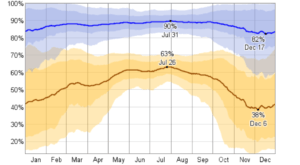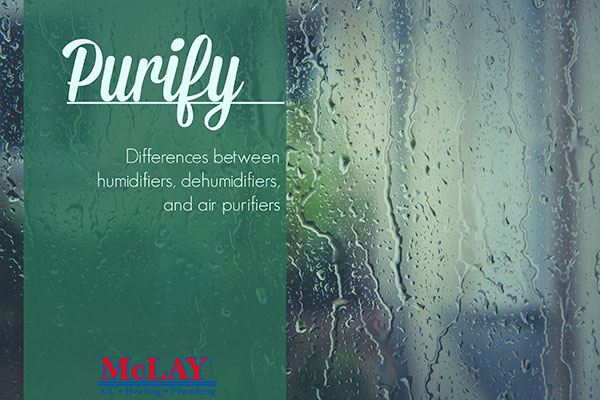Unfortunately, the air inside our homes is not always as comfortable or clean as we would like it to be. Your HVAC system plays a big role in helping keep you and your family healthy and happy. However, sometimes you may need some extra help in controlling humidity levels and filtering out allergens. This simple guide will explain the differences between these three devices and discuss when you should use each to adjust your indoor air quality.
When to Use a Humidifier
Mayo Clinic suggests that ideal indoor humidity is between 30 to 50%. When humidity levels drop below this percentage, the dry air indoors can cause health issues like respiratory distress and dry skin. Low humidity can also cause damage to wooden furniture and cause paper, books, an artwork to warp. A humidifier helps add moisture into the air by emitting water vapor or steam. You can use a stand-alone device to increase humidity in just one room, or add a humidifier as an attachment to your HVAC system to increase moisture levels throughout your home.
Use a humidifier when:
- Using your heater in winter has caused the air inside your home to feel too dry
- You are experiencing dry skin, nose, lips, throat, or sinuses
- Dry indoor air is caused you or your family to have difficulty breathing
- Dry air has triggered nose bleeds, asthma attacks, or allergy symptoms
When to Use a Dehumidifier
Just as the air in your home can become too dry, it can also become too humid. Increased humidity levels and moisture can also cause health issues. Too much moisture not only impacts the comfortability of your home environment but also provides a perfect breeding ground for mold and other bacteria, which can impact your family’s health. A dehumidifier can help you control humidity levels in your home. This device removes moisture from the air, so that you and your family can relax and breathe easier.
Use a dehumidifier when:
- Summer has caused humidity levels to increase inside your home
- The humid air in your home is causing breathing difficulties
- Humid air has triggered allergies for you or your family
- You have experienced flooding in your home
- Your home feels damp or smells musty
Relative Humidity in Los Angeles
Here is a chart for the Los Angeles area (courtesy of weatherspark.com):
The relative humidity typically ranges from 38% (comfortable) to 90% (very humid) over the course of the year, rarely dropping below 13% (very dry) and reaching as high as 100% (very humid).
The air is driest around December 6, at which time the relative humidity drops below 56% (mildly humid) three days out of four; it is most humid around July 31, exceeding 86% (very humid) three days out of four.

The average daily high (blue) and low (brown) relative humidity with percentile bands (inner bands from 25th to 75th percentile, outer bands from 10th to 90th percentile).
When to Use an Air Purifier
The air purifier does not help adjust humidity levels in your home, but it does help protect you and your family against harmful pollutants. An air purifier traps allergens, chemicals, and other tiny particles that can enter your home from outside, triggering allergies, asthma attacks, and other health issues. This device helps you improve indoor air quality to help keep the air in your home or office clean and healthy.
Use an air purifier when:
- You or someone in your home suffers from asthma
- Someone in your household has allergies
- You or someone in your family is sensitive to chemicals
- You have pets, which increase the level of dander in your home
Not sure which device is right for you? If you need some help adjusting your indoor air quality, we are here to help. Contact us today to speak to an HVAC specialist who can help you create just the right environment to keep your family healthy and comfortable.



